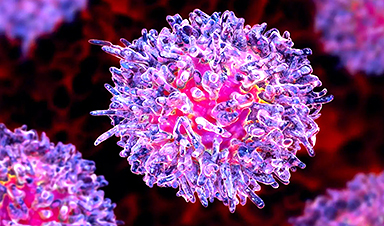Future clinical trials will be conducted to investigate whether the combination of chloroquine and venetoclax can prevent disease recurrence.
Although new drugs have been developed to induce cancer cell death in individuals with acute myeloid leukemia, the leukemic cells often develop resistance and evade the drugs’ effects within a year.
Recently, research conducted using both human tissue samples and mouse models has uncovered that the resistance of leukemia cells to the widely used drug venetoclax is due to an abrupt surge in the breakdown and turnover of mitochondria. These structures within the cell play a crucial role in generating energy and also signal the cell to undergo programmed cell death under certain adverse conditions.
Led by scientists at NYU Langone Health and its Perlmutter Cancer Center, the study showed that mitophagy helps leukemia cells to evade the killing effects of venetoclax, a drug in a class of medications known as BH3 mimetics.
In a study recently published in the journal Cancer Discovery, researchers found that the levels of several genes associated with mitophagy were increased in 20 leukemia patient samples compared with normal controls. The level of these genes was even higher in samples from leukemia patients with drug resistance than in those leukemic patients who were not. Particularly notable was the increased expression of the gene for Mitofusin-2 (MFN2), which codes for a key protein in the outer mitochondrial membrane.
Further experiments using mice into which bone marrow from acute myeloid leukemia patients was transplanted showed that the drug chloroquine, a known mitophagy inhibitor, restored the ability of venetoclax to kill the cancer cells.
“Overcoming resistance to BH3 mimetic drugs like venetoclax is of unique clinical significance because these medications are often used for treating people with acute myeloid leukemia,” said study co-lead investigator Christina Glytsou, Ph.D., a former postdoctoral researcher at NYU Grossman School of Medicine and now an assistant professor at Rutgers University.
“Acute myeloid leukemia is notoriously difficult to treat, with fewer than a third of those affected living longer than five years after their diagnosis, so it is important to maximize the impact of existing therapies,” said study co-lead investigator Xufeng Chen, Ph.D., an instructor in the Department of Pathology at NYU Grossman.
“Our preclinical findings suggest that combining BH3 mimetics like venetoclax with either MFN2 or general mitophagy inhibitors could possibly serve as a future therapy for acute myeloid leukemia, as current drug treatments are stalled due to drug resistance,” said study senior investigator Iannis Aifantis, Ph.D.
Aifantis, the Hermann M. Biggs Professor and chair of the Department of Pathology at NYU Grossman and Perlmutter, says the research team plans to design a clinical trial to test whether chloroquine, when used in combination with venetoclax, prevents drug resistance in people with acute myeloid leukemia.
Speaking about other study results, the researchers say they not only found that MFN2 was overly active in people with drug-resistant disease, but also that cancer cells exposed to similar cell-death-inducing compounds demonstrated a doubling in mitophagy rates.
Additional testing in cancer cells engineered to lack MFN2 showed increased sensitivity to drugs similar to venetoclax compared with cells that had functional MFN2. The new study and previous research by the team showing misshapen mitochondria in drug-resistant leukemic cells confirmed that increased mitophagy was the source of the problem.
Acute myeloid leukemia, the most common form of adult leukemia, originates in the bone marrow cells and involves the rapid buildup of abnormal blood cells. The blood cancer results in the deaths of more than 11,500 Americans annually. Current treatments include chemotherapy and a limited number of targeted drug therapies. Bone marrow transplantation has also been used when other options fail.
Reference: “Mitophagy promotes resistance to BH3 mimetics in acute myeloid leukemia” by Christina Glytsou, Xufeng Chen, Emmanouil Zacharioudakis, Wafa Al-Santli, Hua Zhou, Bettina Nadorp, Soobeom Lee, Audrey Lasry, Zhengxi Sun, Dimitrios Papaioannou, Michael Cammer, Kun Wang, Tomasz Zal, Malgorzata Anna. Zal, Bing Z. Carter, Jo Ishizawa, Raoul Tibes, Aristotelis Tsirigos, Michael Andreeff, Evripidis Gavathiotis and Iannis Aifantis, 24 April 2023, Cancer Discovery.
DOI: 10.1158/2159-8290.CD-22-0601
The study was funded by the National Science Foundation. Additional funding support was provided by the Leukemia & Lymphoma Society and by AstraZeneca, which provided several of the BH3 mimetic drugs used in these experiments.
Aifantis has received additional research funding from AstraZeneca. This arrangement is being managed in accordance with the policies and practices of NYU Langone Health.
News
Two New Books From Frank Boehm, NA Founder – To be Released Dec. 2025
Molecular Manufacturing: The Future of Nanomedicine This book explores the revolutionary potential of atomically precise manufacturing technologies to transform global healthcare, as well as practically every other sector across society. This forward-thinking volume examines [...]
What could the future of nanoscience look like?
Society has a lot to thank for nanoscience. From improved health monitoring to reducing the size of electronics, scientists’ ability to delve deeper and better understand chemistry at the nanoscale has opened up numerous [...]
Scientists Melt Cancer’s Hidden “Power Hubs” and Stop Tumor Growth
Researchers discovered that in a rare kidney cancer, RNA builds droplet-like hubs that act as growth control centers inside tumor cells. By engineering a molecular switch to dissolve these hubs, they were able to halt cancer [...]
Platelet-inspired nanoparticles could improve treatment of inflammatory diseases
Scientists have developed platelet-inspired nanoparticles that deliver anti-inflammatory drugs directly to brain-computer interface implants, doubling their effectiveness. Scientists have found a way to improve the performance of brain-computer interface (BCI) electrodes by delivering anti-inflammatory drugs directly [...]
After 150 years, a new chapter in cancer therapy is finally beginning
For decades, researchers have been looking for ways to destroy cancer cells in a targeted manner without further weakening the body. But for many patients whose immune system is severely impaired by chemotherapy or radiation, [...]
Older chemical libraries show promise for fighting resistant strains of COVID-19 virus
SARS‑CoV‑2, the virus that causes COVID-19, continues to mutate, with some newer strains becoming less responsive to current antiviral treatments like Paxlovid. Now, University of California San Diego scientists and an international team of [...]
Lower doses of immunotherapy for skin cancer give better results, study suggests
According to a new study, lower doses of approved immunotherapy for malignant melanoma can give better results against tumors, while reducing side effects. This is reported by researchers at Karolinska Institutet in the Journal of the National [...]
Researchers highlight five pathways through which microplastics can harm the brain
Microplastics could be fueling neurodegenerative diseases like Alzheimer's and Parkinson's, with a new study highlighting five ways microplastics can trigger inflammation and damage in the brain. More than 57 million people live with dementia, [...]
Tiny Metal Nanodots Obliterate Cancer Cells While Largely Sparing Healthy Tissue
Scientists have developed tiny metal-oxide particles that push cancer cells past their stress limits while sparing healthy tissue. An international team led by RMIT University has developed tiny particles called nanodots, crafted from a metallic compound, [...]
Gold Nanoclusters Could Supercharge Quantum Computers
Researchers found that gold “super atoms” can behave like the atoms in top-tier quantum systems—only far easier to scale. These tiny clusters can be customized at the molecular level, offering a powerful, tunable foundation [...]
A single shot of HPV vaccine may be enough to fight cervical cancer, study finds
WASHINGTON -- A single HPV vaccination appears just as effective as two doses at preventing the viral infection that causes cervical cancer, researchers reported Wednesday. HPV, or human papillomavirus, is very common and spread [...]
New technique overcomes technological barrier in 3D brain imaging
Scientists at the Swiss Light Source SLS have succeeded in mapping a piece of brain tissue in 3D at unprecedented resolution using X-rays, non-destructively. The breakthrough overcomes a long-standing technological barrier that had limited [...]
Scientists Uncover Hidden Blood Pattern in Long COVID
Researchers found persistent microclot and NET structures in Long COVID blood that may explain long-lasting symptoms. Researchers examining Long COVID have identified a structural connection between circulating microclots and neutrophil extracellular traps (NETs). The [...]
This Cellular Trick Helps Cancer Spread, but Could Also Stop It
Groups of normal cbiells can sense far into their surroundings, helping explain cancer cell migration. Understanding this ability could lead to new ways to limit tumor spread. The tale of the princess and the [...]
New mRNA therapy targets drug-resistant pneumonia
Bacteria that multiply on surfaces are a major headache in health care when they gain a foothold on, for example, implants or in catheters. Researchers at Chalmers University of Technology in Sweden have found [...]
Current Heart Health Guidelines Are Failing To Catch a Deadly Genetic Killer
New research reveals that standard screening misses most people with a common inherited cholesterol disorder. A Mayo Clinic study reports that current genetic screening guidelines overlook most people who have familial hypercholesterolemia, an inherited disorder that [...]





















